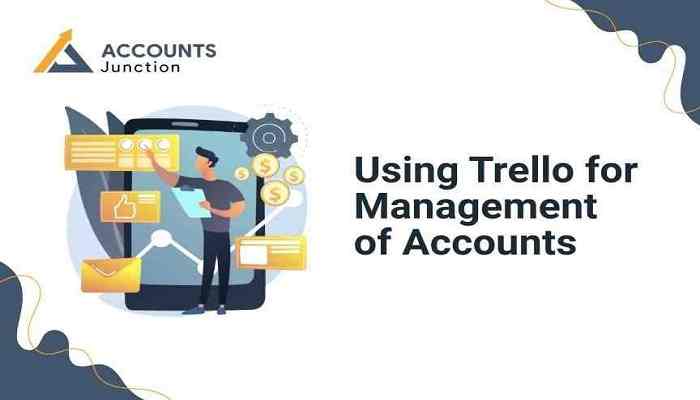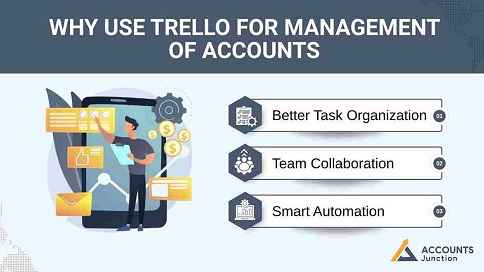
Using Trello for Management of Accounts
Trello is a management tool that helps teams track tasks and stay organized. Many small and mid-size firms use it to plan and manage work every day. Using Trello for management of accounts lets accountants track invoices, budgets, and inventory accounting in one place. Its layout is simple and easy to use. Cards hold due dates, notes, and files. Teams can attach links or documents to cards. This keeps information clear and reduces mistakes
Trello gives a quick look of all tasks in a way you can see what is done and what is pending. It also saves time and keeps records neat and organized. By using Trello, firms can check progress at a glance and quickly find overdue tasks. Managers can see which team members are handling specific tasks. This makes planning and assigning new work easier.
Why Use Trello for Management of Accounts

Here’s why you must use trello for management of accounts:
1. Better Task Organization
Trello uses boards, lists, and cards to keep work organized and in a flow. Accounts payable, receivable, invoices, and taxes can all be tracked through the app. Labels show what is urgent. Checklists break work into small steps. Teams can see what is done and what is still open. This reduces mistakes and missed deadlines. Cards can link related tasks so no step is missed. Teams can plan work and keep track of all tasks at once. Managers can see which tasks take more time and adjust resources. Teams can also mark tasks that require review or approval. This ensures nothing is missed during audits or client reporting.
2. Team Collaboration
Trello allows teams to work in real time. Tasks can be given to a team member, comments added, and files attached. Updates appear right away so everyone knows the latest status. Remote teams can follow work as well as office teams. Teams can talk about tasks on cards instead of email. Notes and reminders show what to do next. Collaboration helps get approvals faster and avoids miscommunication. Teams can also share reports and documents directly on cards. This reduces the risk of lost emails or forgotten notes. By keeping all work in Trello, everyone stays on the same page.
3. Smart Automation
Trello has a tool called Butler that automates repeated tasks. Cards can move automatically between lists, reminders can be sent, and due dates set. Payroll, monthly invoices, and reconciliations can run on schedule. Automation saves time and reduces errors. Accountants can focus on reports and planning. Rules can flag overdue tasks or move them to a review list. Notifications alert teams when work needs action. Automation can also help create recurring checklists, which ensures no step in a process is skipped. This feature reduces the need for manual tracking and improves workflow reliability.
Setting Up Trello for Accounting Workflows
A clear setup makes it easy to track tasks and avoid mistakes.
Boards, Lists, and Cards for Financial Tasks
Boards can be made for payroll, taxes, clients, and inventory accounting. Lists such as Pending, In Progress, and Completed show progress. Cards hold tasks, invoices, or transactions. Cards store notes, due dates, files, and checklists. Checklists break tasks into small steps. This setup helps teams see work at a glance. Cards can link related tasks. Attachments keep contracts, receipts, and approvals in one place for easy access. Teams can also add color labels to mark priority or type of task. Multiple team members can comment on cards to provide updates. This makes communication simple and centralized.
Accounts Payable, Receivable, and Budgeting
Boards track payments and receipts. Labels show urgent or late items. Quarterly lists help check budgets and past spending. Tasks can be assigned to team members. Documents can be stored on cards. Teams can track spending trends and make sure no payment is missed. This setup makes audits easier because all tasks are neat and easy to find. Teams can also compare actual spending with planned budgets directly within Trello. Managers can adjust funds or shift priorities based on this data. This makes financial planning more flexible and accurate.
Trello App Features for Management of Accounts
Custom Boards, Lists, and Cards
Accountants can set up boards for bookkeeping, payroll, taxes, and client accounts. Lists sort tasks by type or status. Cards hold due dates, notes, attachments, and checklists. Custom fields track client details. Work stays organized and tasks are easy to follow. Labels can mark priority or type of task. This helps teams see work at a glance. Teams can add reminders to cards for upcoming deadlines. Cards can also include links to invoices or reports. This keeps all work in one place and makes reporting faster.
Task Automation
Butler automates repeated tasks. Cards move on their own, reminders appear, and recurring tasks repeat. Payroll, invoices, and reconciliations run without manual work. Automation keeps work consistent and cuts mistakes. Late or incomplete tasks can be flagged automatically. Rules can also trigger notifications to managers when tasks fall behind schedule. Teams spend less time checking each step manually.
Integration with Accounting Apps
Trello links with QuickBooks, Xero, and FreshBooks. It connects to Google Drive and Dropbox. All data stays in one place. This reduces manual work and mistakes. Teams can attach spreadsheets, reports, and records to cards. Integration makes audits and reporting faster. Teams can update information automatically across systems. This reduces duplication and ensures accuracy.
Collaboration and Team Management
Tasks can be assigned to team members. Comments, alerts, and notifications keep everyone up to date. Teams can talk on cards instead of email. Tags track responsibility. Alerts warn teams about deadlines. Teams in different places can work together just like office teams. Managers can also track team workload and reassign tasks when needed. This keeps work balanced and ensures deadlines are met.
Budgeting and Expense Tracking
Trello tracks budgets, spending, and accounts. Labels and checklists organize transactions. Accounts payable and receivable are easy to watch. Teams can mark completed payments. Trends can be checked to plan next budgets. Teams can adjust spending when needed. Historical data can be reviewed to avoid overspending. Managers can also set limits and alerts to track major expenses.
Understanding Trello Pricing for Businesses
Free vs Paid Plans
Trello Free Plan
Pros:
- Good for solo accountants or small teams
- Covers simple task and client tracking
- Easy to use
Cons:
- Limited boards and storage
- No advanced fields or timeline views
- No admin controls for large teams
Best for: Small teams or solo accountants with simple workflows
Trello Paid Plans Standard or Premium
Pros:
- Unlimited boards and storage
- Custom fields for client info
- Timeline and calendar views for deadlines
- Automation tools to save time
- Team collaboration tools
Cons:
- Monthly cost per user
- Enterprise pricing can be high for very large firms
Trello Premium vs Enterprise
Trello Premium
Premium helps teams with advanced project features. Views include timeline, calendar, and dashboard. Automation runs without limits. Priority support is included. Premium suits teams managing multiple projects and tasks that need tracking. Teams can use dashboards to see progress across all boards. This helps managers identify bottlenecks early.
Trello Enterprise
Enterprise helps large firms needing strict control. It includes all Premium features and adds company-wide rules and security settings. Enterprise works for large teams with compliance needs. It is good for firms managing many users and projects under rules. Managers can control who sees which boards and set organization-wide standards. This improves security and keeps data safe.
Why Choose Accounts Junction for Trello-Based Accounting Solutions
At Accounts Junction, we use Trello for management of accounts of our clients. Our experts have proven expertise in using Trello app and its features. Here’s why you must choose us:
Trello Setup Experts
We use Trello for management of accounts so that workflows run smoothly and errors drop. Teams can focus on tasks that need skill rather than routine tracking.
Custom Trello Board Setup
Boards, lists, and cards are set for accounts payable, receivable, budgets, and reporting. Each board is tailored to the team’s needs.
Integration with Accounting Software
We link Trello with QuickBooks, Xero, and NetSuite. Manual work drops and mistakes fall. Teams can update client records automatically.
Task Automation
Automation tracks invoices, expenses, and approvals efficiently. Recurring tasks run without manual intervention.
Remote Team Support
Teams can work from any place using the Trello app. Updates and alerts appear in real time. Collaboration remains smooth for remote staff.
Pricing Guidance
We help pick the right plan Free, Premium, or Enterprise based on team size and work needs. Teams pay only for what they use.
Trello makes accounting work clear, neat, and organized. It tracks invoices, payables, receivables, and inventory accounting in one place. Boards, cards, and automation keep work organized and reduce mistakes. Managers can quickly check status and assign work where needed. Trello makes accounting faster, simpler, and more reliable. If you want to shift to Trello for management of accounts, invoices, payables, receivables, and inventory accounting, contact Accounts Junction now.
